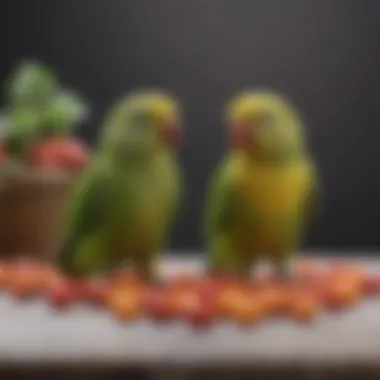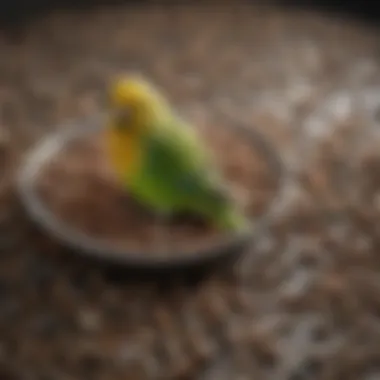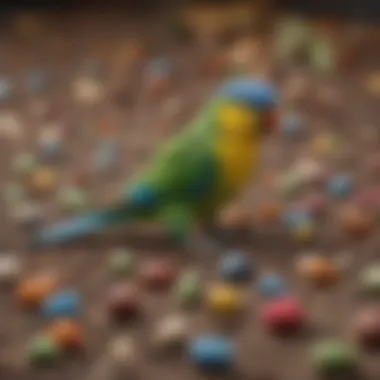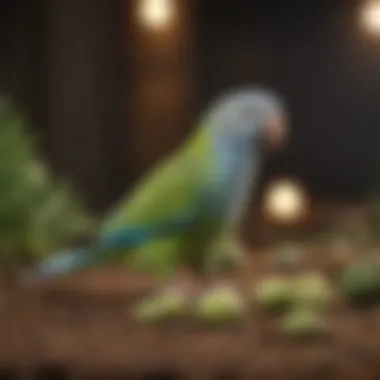Understanding Parakeet Nutrition: A Guide for Owners


Intro
Understanding the nutritional needs of parakeets is vital for pet owners who want to ensure their birds thrive. A balanced diet is more than just providing food; it’s about catering to the specific dietary requirements of these colorful avians. This section will convey essential aspects of parakeet nutrition, serving as a guide to make informed decisions regarding their diet.
Understanding Your Pet
To nurture a parakeet effectively, a basic comprehension of its behavior, breed characteristics, and species-specific needs is crucial. Parakeets, known for their lively nature and sociable behavior, often display quirks that reflect their unique personalities.
Pet Behavior Basics
Parakeets are intelligent creatures. They communicate through chirps and whistles. Observing their body language can unmask feelings, such as fear or excitement. For instance, a parakeet flapping its wings rapidly may indicate distress, while a gently bobbing bird often expresses happiness.
Common Breed Characteristics
There are several breeds of parakeets, each with its traits. The budgerigar is the most popular, with a friendly disposition. Other breeds may vary in size, color, and temperament but share certain dietary requirements. Understanding these characteristics can lead to better care strategies.
Species-Specific Needs
Each parakeet species has specific nutritional requirements. Knowing whether the pet is a budgie or another breed impacts food selection, as certain breeds might need different amino acids or vitamins. This knowledge is vital for formulating a proper diet.
Pet Care and Maintenance
Care for a parakeet encompasses feeding, grooming, and hygiene. Establishing a routine in each area ensures the well-being of the bird.
Feeding Guidelines
A well-rounded diet is necessary. Parakeets primarily thrive on seeds, but they also require pellets, fruits, and vegetables for comprehensive nutrition. Carefully observe their eating habits and preferences to tailor their diet appropriately.
Grooming Essentials
Regular grooming is essential. This includes nail trimming and occasional bathing to keep the feathers in good condition. Lack of grooming can lead to health issues.
Hygiene Practices
Maintaining hygiene in the cage and around the feeding areas is critical. Regular cleaning prevents the buildup of bacteria and other pathogens that could harm the parakeet.
Training and Development
Just like any other pet, training helps parakeets develop social skills and bond with their owners. Proper training techniques are key.
Basic Commands and Skills
Teaching basic commands like
Prolusion to Parakeets
Parakeets are popular pets among bird enthusiasts and families. Understanding their background is crucial for providing optimal care. This section gives insight into the origin of parakeets and various breeds, along with a glimpse into their behavior. This knowledge helps owners appreciate their companions better, guiding them to tailor the feeding and care methods appropriately. Owners who understand their parakeets' needs are more equipped to ensure their health and well-being.
Origin and Breeds
Parakeets originate from Australia, specifically the vibrant, open grasslands. The most common breed is the Budgerigar, often called the budgie. In the wild, beak shapes and colors vary depending on their environment. Through selective breeding, many colors and types of budgies have developed, from bright yellows to softer greens.
Some other breeds include the English Budgerigar and the American Budgerigar. The former is larger and tends to be calmer, making them good companions. The American version is generally smaller, often characterized by a more vibrant feather pattern. It's essential for owners to recognize these differences, as they may affect dietary needs and behavior.
Understanding the differences among parakeet breeds can greatly impact their care. For example, larger breeds might require different housing space and feeding patterns compared to smaller ones. Providing appropriate space and social interaction is also vital for their development.
Understanding Their Behavior
Parakeets are social creatures. In the wild, they live in flocks. This natural tendency means they thrive on interaction with both their bird companions and human owners. Recognizing this behavior is important for fostering a healthy environment for them at home. They communicate using a variety of sounds which indicate their mood and feelings.


When stressed or bored, they may exhibit destructive behavior such as excessive chewing or screaming. Regular interaction and stimulation are required to keep their spirits high. For instance, toys and perches can encourage playfulness, while gentle handling promotes trust between the bird and its owner.
Understanding their social needs can help owners create a nurturing atmosphere, reducing the chances of behavioral issues. This knowledge is especially critical during feeding times, as it can impact their willingness to try new foods. Hence, recognizing the link between behavior and nutrition is essential for any parakeet owner.
Understanding a parakeet's origin and behavior is key to a happy and healthy pet. Knowledge leads to appropriate care, ultimately enhancing their lives.
Nutritional Needs of Parakeets
Understanding the nutritional needs of parakeets is critical for their overall health and well-being. The right diet helps to prevent a variety of health issues, promotes vibrant plumage, and encourages active behavior. Parakeets, being lively and social birds, require a diet that mirrors their natural eating habits. This section will discuss the essential dietary components, focusing on their basic requirements and the significance of both macronutrients and micronutrients.
Basic Dietary Requirements
Parakeets have specific dietary needs that must be met for optimal health. Their primary diet should consist of a balance of seeds, pellets, fresh fruits, and vegetables. Pellets often serve as a reliable base since they are formulated to contain essential nutrients. However, variety is also important.
- Pellets: Designed to provide balanced nutrition, pellets eliminate seed selection, which often results in nutrient deficiencies.
- Seeds: While they can be a part of the diet, they should not be the only source of nutrition. They often are high in fat and can lead to obesity.
- Fruits and Vegetables: Fresh produce adds essential vitamins and minerals. They should be introduced gradually to avoid digestive issues.
In taking care of your parakeet, always ensure clean, fresh water is available. Regularly changing the water and cleaning the bowl can prevent bacteria growth and ensure hydration.
Macronutrients and Micronutrients
Macronutrients and micronutrients play critical roles in maintaining a parakeet's health.
Macronutrients
- Proteins: Essential for growth and feather development, proteins are vital. Sources include legumes, cooked eggs, or high-protein pellets.
- Fats: Necessary for energy and healthy skin, fats should come from safe sources. Nuts can provide healthy fats but should be given in moderation.
- Carbohydrates: While parakeets do require carbohydrates, they should not be the main part of their diet. Grains like oats can be beneficial.
Micronutrients
- Vitamins: Important for metabolic functions. Vitamin A, found in carrots and dark leafy greens, supports vision and immune health.
- Minerals: Calcium is particularly important for bones and eggshell formation. Cuttlebone can serve as an excellent source.
Ensuring that your parakeet receives a variety of macronutrients and micronutrients helps avoid deficiency-related health issues. A well-balanced diet contributes to a longer, healthier life.
A well-rounded diet tailored to meet the nutritional needs of your parakeet not only enriches their life but also enhances the bond between you and your pet. By understanding these fundamental aspects of parakeet nutrition, you will be better equipped to make informed dietary choices.
Types of Parakeet Food
Understanding the different types of food is crucial for ensuring the health of your parakeet. A well-balanced diet plays a significant role in enhancing their well-being and preventing health issues. The categories include pellets, seeds, fruits, and vegetables, each having unique advantages and disadvantages. Selecting the right mix of these foods can enrich your parakeet's life, providing essential nutrients while keeping them engaged.
Pellets: A Balanced Choice
Advantages of Pellets
Pellets offer a tailored nutritional solution for parakeets. They are engineered to provide a balanced diet, ensuring that your bird receives the necessary vitamins, minerals, and macronutrients. One key characteristic is their consistency in nutrient density, making it easier for pet owners to regulate daily intake. Unlike seeds, pellets contain no sunflower seeds or other high-fat components that parakeets tend to overeat. This feature allows for better management of a parakeet's weight and overall health.
Disadvantages of Pellets
Though pellets have many advantages, there are downsides. Some parakeets may not take to pellets immediately, as they often prefer the taste of seeds. This can lead to a reluctance to eat, potentially causing nutritional deficiencies. A unique disadvantage is that if a bird only eats pellets, it might miss out on the sensory enjoyment that comes from various textures and flavors found in other foods. Hence, balancing pellets with seeds or fresh produce is important.
Seeds: The Traditional Option
Types of Seeds
Seeds are often considered the traditional choice for parakeets. Various types are available in the market, including millet, canary seed, and oat groats. Each type has distinctive appeal and can offer different nutritional benefits. Millet is a favorite among many parakeets due to its small size and crunchiness while offering a source of carbohydrates. Contrary to pellets, seeds can also provide diverse textures that many birds enjoy.
Nutritional Content
It's essential to examine the nutritional content of seeds. Typically, seeds provide high fat and carbohydrates, which provide lots of energy. However, they may lack essential vitamins and minerals, which are critical for your parakeet’s overall health. Many pet owners mistakenly believe that seeds alone can meet their birds' dietary needs, but this is not sufficient for promoting long-term health.
Potential Risks
Relying heavily on seeds can pose risks to parakeets. One major concern is the tendency for birds to become overweight due to the high-fat content of many seeds. Additionally, the imbalances in essential nutrients can lead to deficiencies over time. Therefore, a varied diet is essential for preventing health issues and ensuring your parakeet thrives.


Fruits and Vegetables: The Natural Additions
Best Choices for Parakeets
Fruits and vegetables should be integral to a parakeet's diet. Opt for safe options like carrots, spinach, apples, and sweet potatoes. These foods are packed with vitamins, fiber, and hydration that seeds and pellets might lack. The vibrancy of fresh produce appeals to birds and can encourage them to eat healthily.
How to Introduce Them
Introducing fruits and vegetables to your parakeet's diet should be gradual. Start with small amounts to gauge interest. If your parakeet shows curiosity, it is likely to try new foods. It’s crucial to chop them into manageable pieces to prevent choking hazards, making it easier for your bird to explore this new food option.
Commercial vs.
Homemade Diets Choosing between commercial and homemade diets is a personal decision for pet owners. Commercial options like specialized seed mixes or pellets can offer convenience and clarity in nutritional content. On the other hand, homemade diets allow for more control over specific ingredients. Ensure that any homemade option meets the dietary needs of your parakeet to avoid deficiencies.
The selection of the right food type is critical for protecting the health of your parakeet. Ensure a blend of food options to create a balanced diet, contributing to a healthier and more fulfilling life.
Best Practices for Feeding Parakeets
Feeding parakeets is more than just filling a bowl with seeds. It requires understanding their health, habits, and nutritional needs. Implementing best practices in feeding can significantly improve their overall well-being. This section breaks down essential strategies that can lead to healthier diets for your feathered friends.
Portion Control and Feeding Schedule
Portion control is a critical aspect of feeding parakeets. Overfeeding can lead to obesity, which is a serious concern in avian pets. To avoid this, pet owners should establish a feeding schedule, focusing on the right amounts of food for their parakeets' size and breed. Generally, it's best to provide about one tablespoon of seed or pellet per bird daily. A consistent feeding time can help regulate their metabolism and encourage routine.
Another important aspect is the feeding environment. Ensure that their dining area is clean and free from disturbances. Parakeets are sensitive creatures and benefit from a calm atmosphere during mealtimes. Additionally, it is advisable to monitor their eating habits. If they consistently leave food uneaten, consider adjusting the portion size to prevent wastage.
Introducing New Foods Gradually
Changing a parakeet’s diet should be a gradual process to avoid digestive issues. Birds are creatures of habit, and sudden changes in their diet can cause stress and confusion. To introduce new foods, start by mixing a small quantity of the new item in with their usual food. Gradually increase the proportion of the new food over a week or two while observing their reactions.
Include a variety of foods to enrich their diet. Fresh fruits and vegetables can be a nutritious addition. Offer small, manageable pieces to make it easier for them to consume. Choices like carrot sticks, apple slices, and leafy greens are typically well-received. However, always research which foods are safe for them and ensure any new additions are fresh and clean.
Tip: Keep a diary of your parakeet's feeding habits. Note which new foods they accept or reject, which can help in planning their diet effectively.
In summary, adopting best practices such as portion control and gradual introduction of foods is vital for the health of parakeets. By doing so, pet owners contribute to their pets’ longevity and happiness.
Common Dietary Mistakes
Understanding common dietary mistakes is vital for every parakeet owner. Many pet owners inadvertently jeopardize their parakeet’s health by sticking to poor nutritional choices. Often, this stems from misunderstanding their dietary needs or from the convenience offered by certain food types. Recognizing these mistakes helps ensure a healthier and happier bird. A balanced diet can greatly influence their behavior, plumage, and overall well-being.
Overreliance on Seeds
Seeds have long been considered a staple in the diet of parakeets. They are easy to obtain and are often viewed as a treat. However, relying too much on seeds can lead to various health problems. Seeds do not provide the full range of nutrients that parakeets require. Most seeds are high in fat but low in other essential nutrients.
This overreliance can cause obesity, liver disease, and other metabolic disorders. For instance, sunflower seeds, while popular, contain high levels of fat and can contribute to weight gain if consumed excessively. Ideally, seeds should only comprise a small part of a well-rounded diet.
Here are some guidelines to reduce the overreliance on seeds:
- Limit seed portion: Provide seeds as treats or in smaller quantities.
- Introduce pellets: Consider high-quality pellets that are designed to offer balanced nutrition.
- Monitor behavior: Keep an eye on your parakeet's activity level and weight to detect any health issues early on.
Inadequate Fresh Produce
Fresh fruits and vegetables are crucial for the health of parakeets. They provide essential vitamins and minerals not found in seeds or pellets. Unfortunately, many owners do not include enough fresh produce in their birds' diet.
Without sufficient fresh produce, parakeets may suffer from deficiencies in vitamins like A and C. This can lead to various health issues, including weakened immune systems, poor feather quality, and even nutritional blindness.
To enhance their diet with fresh produce, keep the following points in mind:
- Variety is Key: Offer a range of fruits and vegetables to cover different nutritional needs. Good options include leafy greens, carrots, and apples.
- Wash thoroughly: Always wash fruits and vegetables properly to remove any pesticides or chemicals.
- Introduce Gradually: Just like with any new food, introduce fresh produce gradually to avoid digestive upset.
Health Implications of Diet


When caring for parakeets, proper nutrition is essential for their overall health and well-being. The food you provide influences various aspects of your pet's life, including energy levels, lifespan, and behavioral traits. Understanding how diet directly affects health can help pet owners make informed decisions about their feathered friends' meals.
Recognizing Nutritional Deficiencies
Nutritional deficiencies in parakeets can manifest in several ways. Common signs include lethargy, changes in plumage, and behavioral shifts. For instance, a parakeet lacking vitamin A may develop respiratory issues and poor feather quality. Similarly, a deficiency in calcium can lead to weak bones or an increased risk of fractures. To recognize these deficiencies, pet owners should observe their parakeet's physical condition closely. Regular check-ups with an avian veterinarian are also recommended for early detection.
Important: Always consult with a vet if you notice significant changes in your bird's behavior or appearance. Early diagnosis can prevent serious health issues.
To prevent nutritional deficiencies, consider the following:
- Diversify the diet: Include a mix of pellets, seeds, and fresh produce.
- Monitor portion sizes: Overfeeding a single food type can lead to imbalances.
- Rotate food offerings: This helps ensure a wider range of nutrients.
Maintaining Optimal Weight
Maintaining an appropriate weight is crucial for parakeets. Obesity can lead to various health problems, including heart disease and diabetes. Owners should regularly monitor their parakeet's weight and body condition. A healthy parakeet should have a well-proportioned body without excessive fat deposits.
To maintain an optimal weight, consider the following strategies:
- Establish a feeding schedule: This helps in controlling portions and reducing overeating.
- Limit high-calorie treats: While seeds are a favorite, they can be calorically dense. Balance them with low-calorie fruits and vegetables.
- Provide ample exercise opportunities: Encourage your parakeet to fly and play, which promotes healthy body weight.
Engaging Your Parakeet During Feeding
Engaging your parakeet during feeding is more than just a routine. It plays a critical role in their overall health and well-being. Parakeets are intelligent creatures that thrive on interaction. A stimulating feeding environment can prevent boredom and encourage natural foraging behavior. When a parakeet is engaged, it not only enjoys its meal but also maintains mental sharpness. This interaction can help to form a stronger bond between pet and owner. Additionally, it can aid in reducing stress, leading to a happier, healthier bird.
Interactive Feeding Techniques
One effective method for engaging parakeets involves various interactive feeding techniques. You can use toys that dispense food, making the feeding process an activity. For example, a foraging toy allows parakeets to work for their meal. This mimics the natural behavior of searching for food in the wild. It keeps them mentally stimulated and encourages physical activity.
Another technique is to hide small amounts of food around their cage. This challenges them to explore their environment. You might also consider using different feeding times or varying the type of food each day. Changing routines can keep your parakeet alert and curious.
Here are some interactive methods:
- Foraging Toys: Items that release food as they play.
- Hide-and-Seek: Place food in different spots in the cage.
- Timed Feeders: Use a feeder that opens only at specific times.
Implementing these techniques can engage your parakeet's mind and body, enhancing its health.
Importance of Social Interaction
Social interaction is essential for the emotional health of parakeets. These birds are naturally social animals that thrive when they have companionship. Regular interaction during feeding strengthens the bond between the pet and its owner. When parakeets feel a sense of belonging, they are less likely to experience anxiety and stress.
During feeding time, take the opportunity to talk to your parakeet or even sing. Your voice can be comforting. This interaction not only helps with bonding, but it may also encourage positive behavior. Engaging in these activities during meal times can help your parakeet feel more secure and content.
Ultimately, a parakeet that is well-fed and socially engaged will be more active and healthier. Keeping an eye on their behavior during these moments can also provide insight into their emotional state. This awareness allows you to adapt your approach as needed to meet their specific needs.
Remember: By providing both interactive feeding options and ensuring regular social interaction, you contribute significantly to the quality of life of your parakeet.
Epilogue
The culmination of our exploration into parakeet nutrition highlights the essential aspects of providing a balanced diet. This guide has emphasized that understanding your parakeet's dietary needs is not just a matter of feeding; it is about fostering their health and happiness.
By focusing on the variety of food options, the significance of a well-rounded diet cannot be overstated. A diverse diet comprising pellets, seeds, fresh fruits, and vegetables promotes not only physical health but also mental stimulation. The interaction during feeding times strengthens the bond between pet owners and their feathered companions. This connection enhances overall well-being.
Feeding practices significantly impact parakeets' longevity and quality of life. Paying attention to portion control and being aware of common dietary mistakes are crucial to preventing nutritional deficiencies or obesity. A commitment to learning about these animals' needs will ensure they thrive under your care.
"A well-fed parakeet is a happy parakeet."
Summary of Key Points
- Parakeets require a balanced diet that includes a variety of food sources such as pellets, seeds, fruits, and vegetables.
- Pellets are often recommended for their nutritional completeness, while seeds can form part of their diet.
- Fresh produce is vital for providing essential vitamins and minerals, supporting parakeets' health.
- Owners should remain vigilant about portion sizes to avoid overfeeding or nutritional imbalance.
- Engaging with parakeets through interactive feeding can enhance their overall happiness and mental well-being.
Encouraging Lifelong Learning
Understanding the nutritional needs of parakeets does not end with a one-time reading. It is necessary to continually educate yourself as a pet owner. The world of pet care and nutrition is always evolving, with new information emerging regularly.
Regularly check credible resources like en.wikipedia.org or britannica.com to stay informed about the latest recommendations on avian nutrition. Participate in communities, such as those on reddit.com, where pet owners share knowledge and experiences. These interactions can provide valuable insights into best practices and innovative feeding techniques.
By staying informed, you will be better equipped to make choices that positively impact your parakeet's life, ensuring they receive the best care possible.







